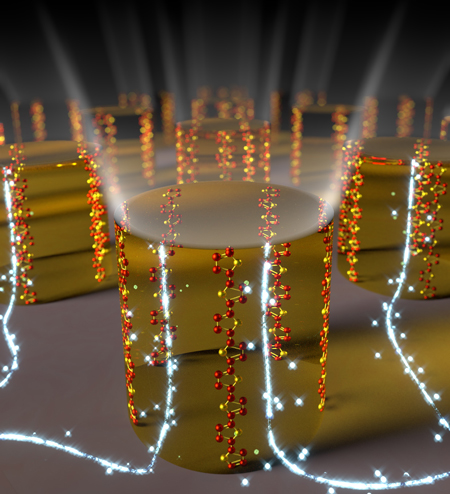| Posted: Jan 28, 2016 |
Breakthrough enables ultra fast transport of electrical charges in polymers
(Nanowerk News) A research team at Umeå University in Sweden has showed, for the first time, that a very efficient vertical charge transport in semiconducting polymers is possible by controlled chain and crystallite orientation. These pioneering results, which enhance charge transport in polymers by more than 1,000 times, have implications for organic opto-electronic devices recently published in the journal Advanced Materials.
|
|
Conjugated semiconducting polymers (plastic) possess exceptional optical and electronic properties, which make them highly attractive in the production of organic opto-electronic devices, such as for instance photovoltaic solar cells (OPV), light emitting diodes (OLED) and lasers.
|
|
Polythiophene polymers, such as poly(3-hexylthiophene), P3HT, have been among the most studied semiconducting polymers due to their strong optical absorbance and ease of processing into a thin film from solution. In both OPVs and OLEDs, charges must be transported in the out of plane (vertical) direction inside the polymer film.
|
|
However, until now the vertical charge carrier mobility of organic semiconductors, i.e. the ability of charges to move inside the material, has been too low to produce fast charge transport in electronic devices. Faster charge transport can occur along the polymer chain backbone. However, a method to produce controlled chain orientation and high mobility in the vertical direction has remained elusive until now.
|
 |
| Vertically aligned chains in the organic semiconducting polymer inside microscopic patterns. (Image: Umeå University)
|
|
In the present work ("Ultrahigh Mobility in an Organic Semiconductor by Vertical Chain Alignment"), a team of chemists and materials scientists, led by Professor David R. Barbero at Umeå University, has found a new method to align chains vertically and to produce efficient transport of electric charges through the chain backbone. In this new study, moreover, high charge transport and high mobility were obtained without any chemical doping, which is often used to artificially enhance charge transport in polymers.
|
|
“The transport of electric charge is greatly enhanced solely by controlled chain and crystallite orientation inside the film. The mobility measured was approximately one thousand times higher than previously reported in the same organic semiconductor,” says David Barbero.
|
|
In what way will these results affect the field of organic electronics?
|
|
“We believe these results will impact the fields of polymer solar cells and organic photodiodes, where the charges are transported vertically in the device. Organic-based devices have traditionally been slower and less efficient than inorganic ones (e.g. made of silicon), in part due to the low mobility of organic (plastic) semiconductors. Typically, plastic semiconductors, which are only semi-crystalline, have hole mobilities about 10,000 times lower than doped silicon, which is used in many electronic devices. Now we show it is possible to obtain much higher mobility, and much closer to that of silicon, by controlled vertical chain alignment, and without doping,” says David Barbero.
|
|
The charge transport was measured using nanoscopic electrical measurements, and gave a mobility averaging 3.1 cm2/V.s, which is the highest mobility ever measured in P3HT, and which comes close to a theoretical estimation of the maximum mobility in P3HT. Crystallinity and molecular packing characterisation of the polymer was performed by synchrotron X-ray diffraction at Stanford University’s National Accelerator (SLAC) and confirmed that the high mobilities measured were due to the re-orientation of the polymer chains and crystallites, leading to fast charge transport along the polymer backbones.
|
|
These results, published in Advanced Materials, may open up the route to produce more efficient organic electronic devices with vertical charge transport (e.g. OPV, OLED, lasers etc.), by a simple and inexpensive method, and without requiring chemical modification of the polymer.
|
|
About plastics
|
|
Regular plastic materials are non-conducting, but if they contain conjugated double bonds, with delocalized electrons, which run alongside the chain backbone, they can conduct charges and transport electricity. However, these electrons (or their positive counterpart, holes) are still not as mobile as in metals or silicon, and therefore their mobility is much lower. To increase the charge mobility, the polymer is usually doped, which means introducing impurities into the material for the purpose of modulating its electrical properties.
|

